Key takeaways:
- Compost bins transform kitchen scraps and yard waste into nutrient-rich soil, promoting sustainable living and reducing waste.
- Key factors for successful composting include proper ventilation, moisture balance, and knowing what materials to add or avoid.
- Maintaining a compost bin requires consistency, regular aeration, and monitoring moisture levels for effective decomposition.
- Using compost creatively can enhance garden health, serving as a natural fertilizer and improving soil quality for plants and lawns.
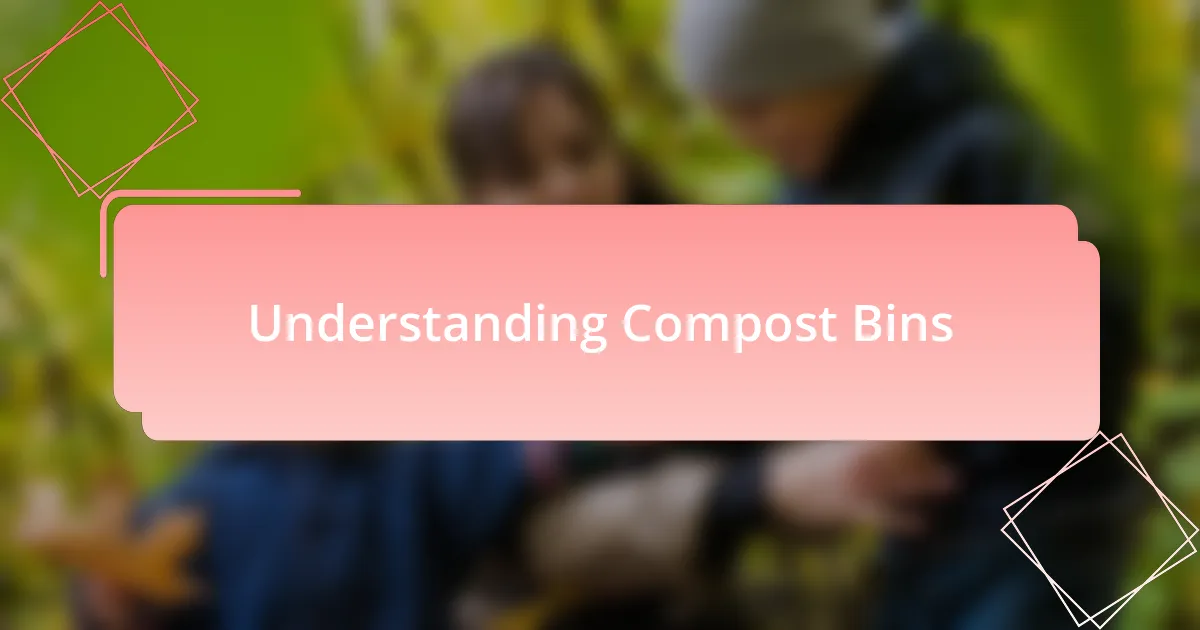
Understanding Compost Bins
Understanding compost bins starts with recognizing their purpose: they transform kitchen scraps and yard waste into nutrient-rich soil. I still remember the first time I tossed banana peels into my homemade compost bin; it felt like I was giving back to the earth in a small yet impactful way. Have you ever thought about how much waste can be repurposed? A good compost bin not only reduces waste but also benefits your garden, creating a closed-loop system that aligns with sustainable living.
A crucial aspect of a compost bin is its design—ventilation and drainage are key to aerobic decomposition. I made the mistake of sealing mine too tightly at first, which led to unpleasant odors and a soggy mess. Learning to balance moisture and airflow was a game changer; it’s fascinating how something as simple as a few holes can make a big difference. Imagine turning organic waste into rich compost; it’s like turning trash into treasure.
Finally, understanding compost bins also involves knowing what to add and what to avoid. For instance, while fruit scraps are a great addition, meat or dairy can cause unwanted pests. I once learned this the hard way—finding fruit flies buzzing around my bin sparked my curiosity to delve deeper into the composting world. What about you? Are there particular food scraps you’d like to recycle? Think of your compost bin as a mini ecosystem, thriving on balance and care, teaching us about nature in the process.
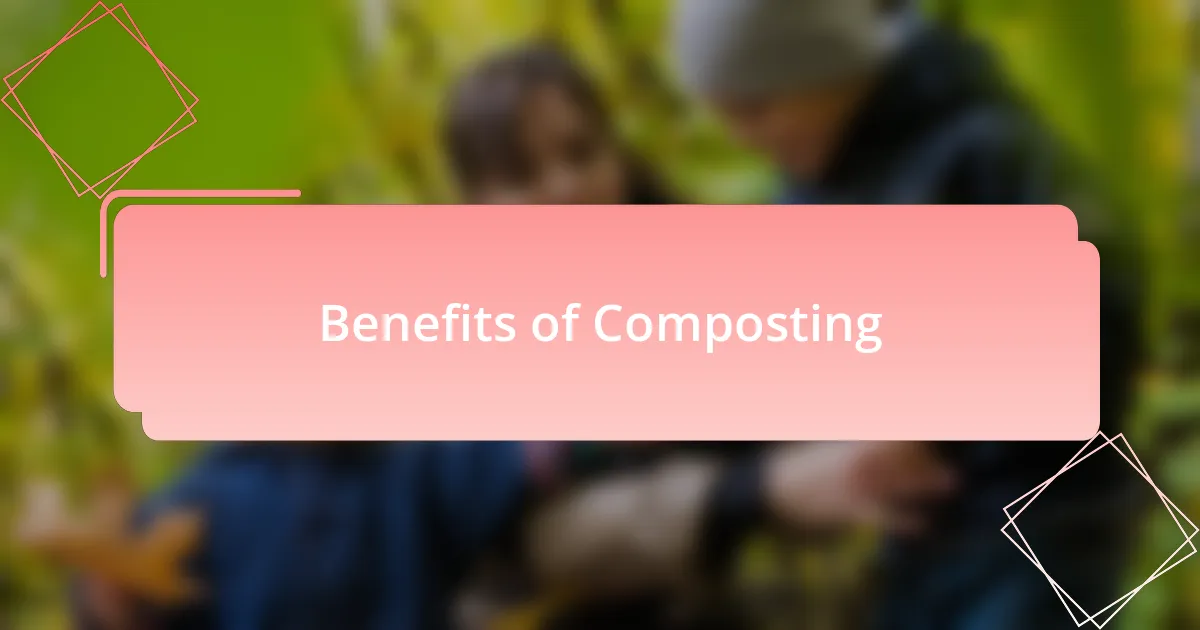
Benefits of Composting
Composting delivers numerous benefits beyond simply reducing waste. For me, the most rewarding aspect has been the transformation of my garden soil. After a few months, I noticed an undeniable difference—my plants thrived, and the colors seemed more vibrant. Isn’t it satisfying to see direct results from such a small effort?
Furthermore, composting plays a vital role in environmental conservation. By using kitchen scraps and yard waste, I’ve reduced my household’s carbon footprint. Every time I add organic matter to my bin, I can’t help but think about how much potential is unleashed when we choose to recycle these materials instead of letting them contribute to landfill problems. Doesn’t it feel good to know you’re making a positive impact?
Lastly, I’ve learned that composting fosters a deeper connection with nature. It encourages mindfulness about what we throw away and how we can contribute to the earth’s ecosystem. Reflecting on my journey, I realize that each layer I added to my bin was not just waste but part of a cycle. Have you ever stopped to think about the stories your scraps could tell? Composting truly feels like a partnership with nature, showing us the beauty of regeneration and growth.
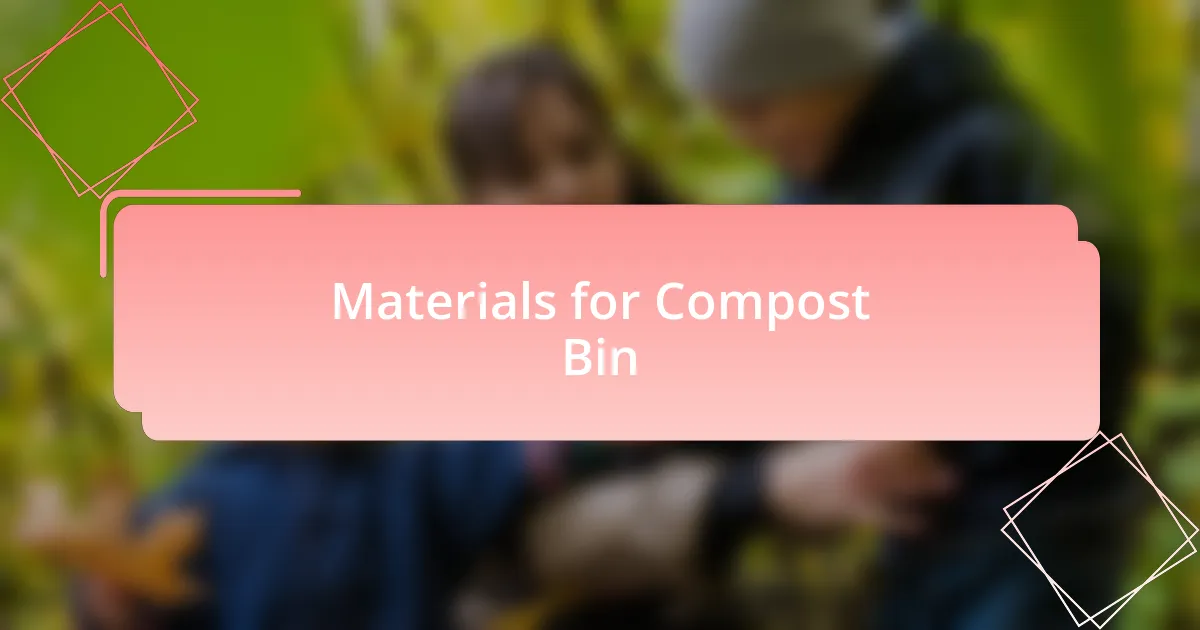
Materials for Compost Bin
When I set out to build my compost bin, I focused on selecting materials that would ensure durability and functionality. The main structure of my bin was crafted from untreated wood, which not only blends beautifully with my garden but also decomposes naturally over time without leaching harmful chemicals into the compost. Do you think about how your choices impact the earth when you work on home projects?
In addition to wood, I included wire mesh to keep pests at bay while allowing airflow. This was a game changer for me. I remember being frustrated when I discovered an uninvited raccoon rummaging through my scraps! After this amendment, I felt a sense of relief knowing my compost would stay protected and thrive. It’s amazing how a few simple materials can create a balance between nature and my little home ecosystem.
I also made sure to layer in materials like cardboard and straw. These not only provide the necessary carbon but help with drainage as well. I still get excited when I see how these layers break down over time, turning what was once trash into nourishing soil. When was the last time you felt that thrill in your gardening journey?
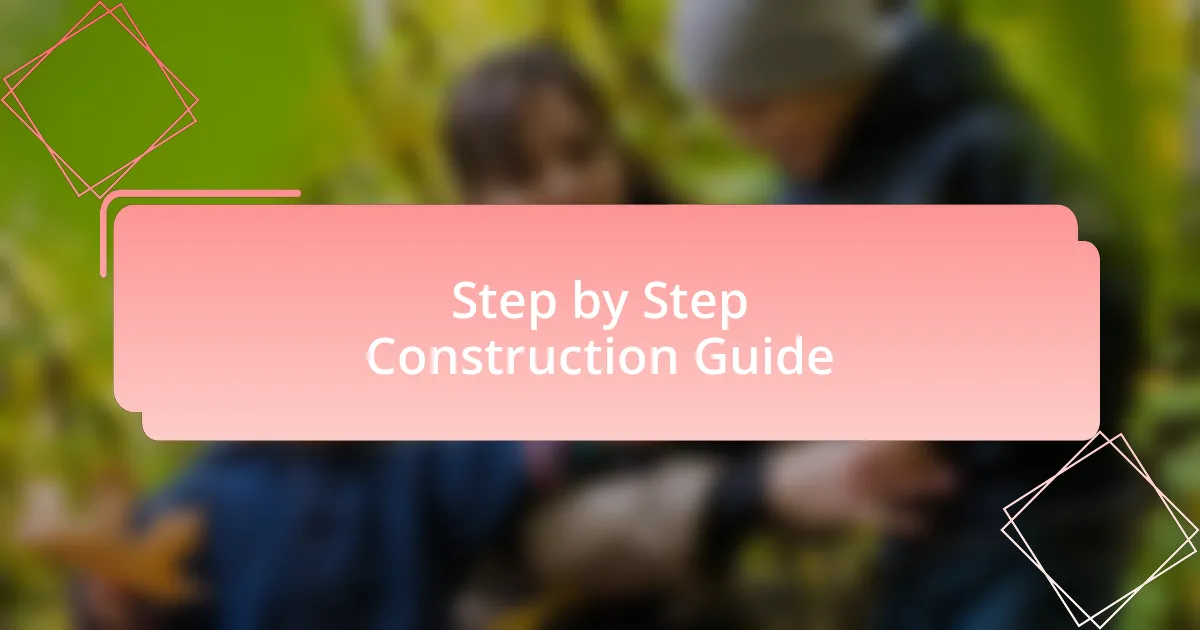
Step by Step Construction Guide
When it came to building the frame of my compost bin, I decided on dimensions that suited not just my garden’s size but also the volume of kitchen scraps I usually produced. I remember sketching out a simple design on a napkin—there’s something incredibly satisfying about turning an abstract idea into a tangible project. My bin ended up being 3 feet by 3 feet, the perfect size for aeration and easy access. Have you ever paused to measure and visualize a project before diving in?
To bring the whole structure together, I utilized galvanized screws instead of nails for strength and longevity. I was working in the late afternoon sun, and every turn of the screwdriver made me think about the little changes I was making not just in my home, but in the environment as well. It really does feel rewarding to know that I’m investing time in a sustainable solution.
As for the assembly, I laid the pieces out on the ground first to ensure it fit perfectly. I vividly recall feeling the weight of anticipation each time I added a new panel. Fastening those final screws felt like sealing a pact with the earth and my future garden. Have you ever felt that connection while creating something that would give back? It’s a delightful reminder of life’s cyclical nature.
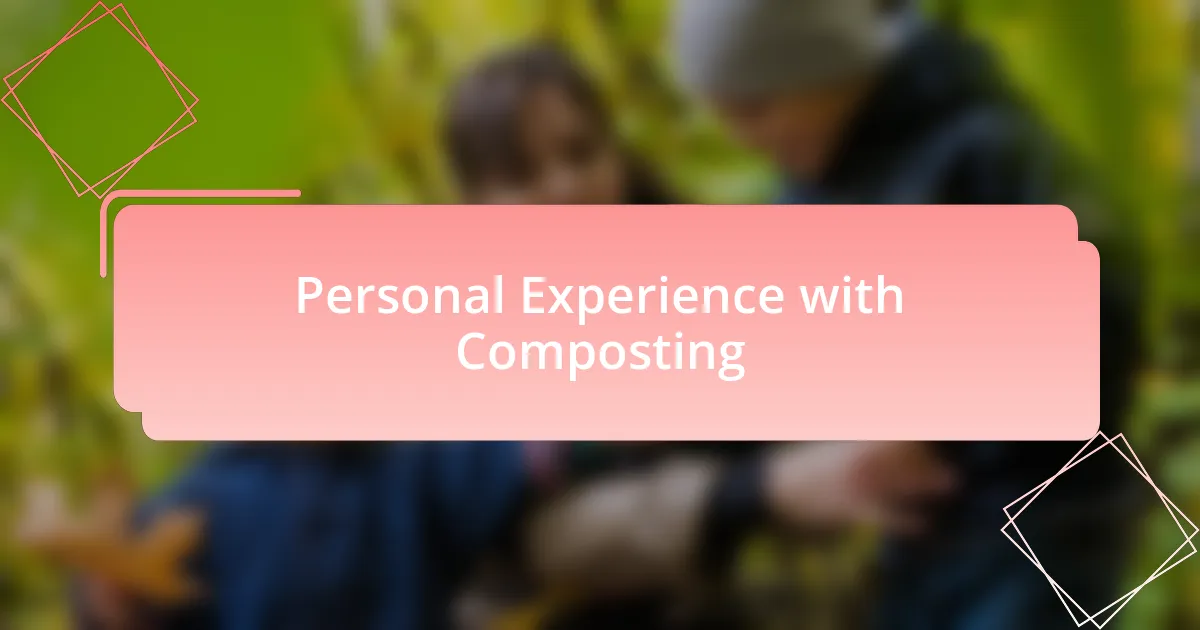
Personal Experience with Composting
As I dove into the world of composting, I quickly became fascinated by the transformation of food scraps into nutrient-rich soil. I can still remember the first time I opened the bin after a few weeks of layering green and brown materials. The earthy smell and the sight of the decomposing matter evoked a sense of accomplishment that I hadn’t felt in a long time. Has there been a moment in your life when you’ve realized your efforts were making a tangible difference?
One of the surprises for me was how much my kids wanted to get involved in the composting process. I recall my youngest, with her little hands digging through the bin, discovering worms and eager to learn about their vital role in breaking down the organic matter. It struck me that composting could be a bonding experience, one that connected us to nature and to each other. Don’t you think sharing such experiences can deepen our appreciation for the environment?
Occasionally, I would hit roadblocks, like discovering my compost was too wet or not decomposing as expected. Those challenges taught me patience and observation. I found myself cheering on the slow process of decomposition, learning to adjust the balance of materials. It reminded me life often requires us to embrace the mess along with the progress. Have you ever faced a setback that turned out to be a valuable lesson?
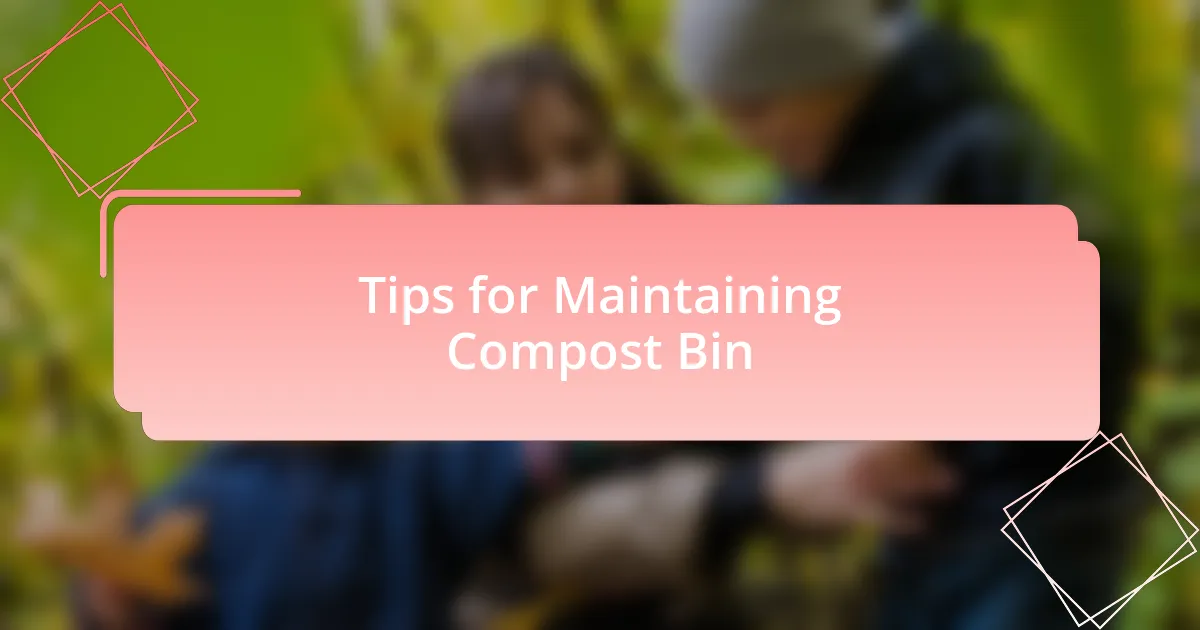
Tips for Maintaining Compost Bin
Maintaining a compost bin can feel a bit overwhelming at times, but I found that consistency is crucial. During my early composting days, I would forget to turn the pile, which hindered its decomposition. Once I established a routine, I noticed a significant difference. Have you ever experienced that sense of relief when things start flowing smoothly again?
One practical tip I learned is to keep an eye on the moisture level. If you ever find your compost bin too dry, sprinkle some water and mix in kitchen scraps to revive it. I vividly remember one hot summer day when I neglected to check my bin, only to find it dry as a desert. A quick sprinkle and a good turn made all the difference—it was such a simple fix! Doesn’t it feel good to troubleshoot like that?
Aeration is another vital part of composting that I initially underestimated. Turning the pile allows oxygen to circulate, which speeds up the decomposition process. I recall vividly the time I decided to turn my compost after a few weeks and was blown away by the heat radiating from it. It felt like I was nurturing a living organism rather than a mere pile of waste. Have you felt that rewarding warmth from your compost?

Creative Ideas for Compost Use
Finding creative ways to use compost in my garden has been both rewarding and fulfilling. One of my favorite tricks is to mix compost into my potting soil when starting new plants. The first time I did this, I noticed how vibrant and healthy my seedlings became. Have you ever had that moment where you realize you’ve created a mini-ecosystem just by adding a simple ingredient? It’s empowering!
Another great use for compost is as a natural fertilizer for my flower beds. The first spring I spread compost around my roses, the blooms were richer and more vibrant than ever before. I couldn’t help but feel pride walking past my garden, knowing I had contributed to that beauty through my composting efforts. Does your garden have a space waiting for a touch of this nutrient-rich gold?
I also discovered that compost can work wonders as a top dressing for my lawn. When I applied it for the first time, I saw a difference in both the color and texture of the grass within weeks. It felt like giving my yard a special treat. Have you thought about how simple changes can lead to such a lush environment? I encourage you to try using compost in unexpected ways; you might be surprised at the results!